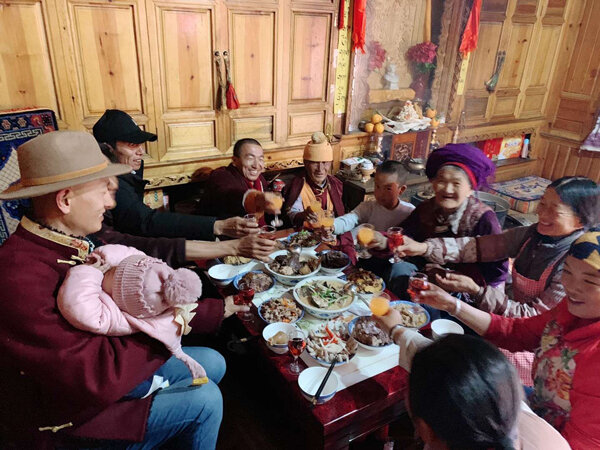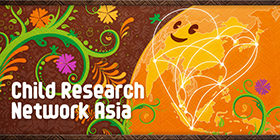"Ku shi, ku shi, kuan ke ha mi wa le da a wo sheng" is a Mosuo proverb about the Spring Festival, meaning that Mosuo people who are away from home or wanderers will always find their way back home.*1 It implies that no matter where the Mosuo people are, they will return home to reunite with their families during the New Year. The Mosuo Spring Festival lasts for a total of 15 days, but the Mosuo people need to perform a series of rituals before the Spring Festival to prepare for the celebration. Therefore, they can pass on to children many ancient Mosuo cultural practices through the ceremonies during the Spring Festival.
1. Preparations Before the Spring Festival
Preparations for the Spring Festival usually begin in the twelfth month of the lunar calendar. The Mosuo people gradually transitioned from a nomadic lifestyle to an agricultural one, eventually settling and thriving around Lugu Lake, a practice that continues to this day. Due to their unique way of life, the Mosuo people's preparations for the Spring Festival differ somewhat from those in other regions. Before the Spring Festival, every Mosuo household first cleans out the manure from the livestock pens and transports it to the fields. This not only cleans the livestock's living quarters before the New Year but also nourishes the land. More importantly, these preparations are also meant to ensure that the livestock can celebrate the New Year. Typically, neighbors help each other with these tasks, taking turns to complete them.
Additionally, the men of the household have another task: they need to repair the livestock pens and groom the animals. If they have horses, they will braid colorful decorations into the horses' manes; if they have cattle, they will hang pleasant-sounding bells around their necks. These rituals symbolize the prosperity of the livestock.
Mosuo women begin preparing to make puffed rice candy at the start of the twelfth lunar month. The first step in making rice flower candy is to sprout barley. They place prepared barley on a sprouting rack to cultivate it, and once the barley grains sprout, they can cook the syrup. During this process, they also take out two beautiful bundles of barley sprouts and place them by the hearth as an offering to Ranbala, symbolizing the vitality of the coming year.*2 Next, they use their own corn and rice to make popcorn and puffed rice at a designated place. Finally, they combine the malt syrup and popcorn to create various types of rice flower candy.
It is best if all the ingredients for making puffed rice candy come from their own household, as some of the candy is used for offerings to the gods, some is placed in New Year's gift boxes, and the rest is used as New Year's snacks. This practice not only gathers the fruits of their labor but also serves as a prayer for a bountiful harvest in the new year.
In addition to the preparations mentioned above related to their methods to make rice puff candies, the Mosuo people have another very important ritual for the Spring Festival: the ritual to ward off evil. Before the Kitchen God Festival, the Mosuo people will choose an auspicious day, ensuring that the zodiac sign of that day does not conflict with the zodiac signs of any family members. On this chosen day, they conduct a thorough cleaning of their homes, and after the cleaning, they invite a lama or a Daba (a Mosuo shaman) to perform the obstacle-clearing ceremony.*3 If they do not encounter a suitable auspicious day before the Kitchen God Festival, they can choose to conduct the thorough cleaning and obstacle-clearing ceremony on the day of the Kitchen God Festival itself. This is done to pray for safety and peace in the coming year.
After the Kitchen God Festival, the Mosuo people no longer engage in large-scale labor. Those who are at home begin to wash clothes, make prayer flags, and prepare snacks. Meanwhile, Mosuo people who are away from home start preparing to return home to reunite with their families.
2. Etiquette During the Spring Festival
The Mosuo people officially enter the Spring Festival on New Year's Eve. On the morning of New Year's Eve, they begin by putting up spring couplets and hanging prayer flags. A unique tradition among the Mosuo is that, in addition to putting up spring couplets, they also insert lush tree branches into the doors of each room. These branches are chosen from a local highland plant similar to the camellia but not the same, known in the Mosuo language as Canhu.*4 This symbolizes the arrival of spring.
The lunch on New Year's Eve is quite special. This meal must include the making of baba (a type of cake), with glutinous rice baba being the best. Additionally, there must be a dish of stir-fried sauerkraut, such as sauerkraut with meat. Traditionally, the Mosuo people do not often stir-fry dishes; they usually stew or boil their food. The reason for stir-frying this meal is to offer it to the gods. Firecrackers are set off during this lunch as a way to invite the ancestral spirits into their home. Following this, the whole family begins preparing for the New Year's Eve reunion dinner.
(a) New Year's Eve
Before the reunion dinner, the woman of the house presents the prepared New Year's ingredients as offerings at various places where deities such as Ranbala and Sītúkè are enshrined, and the Buddhist altar. The offerings include fruits, sweets, tea, salt, wine, beverages, and so on. All offerings must be new, and it is best if they come from the family's own labor. After offering to the gods, the Mosuo people begin their reunion dinner.
If there has been a death in the family, the New Year's Eve dinner preparations are done early. They perform ancestor worship and have their reunion meal early because the Mosuo believe that their ancestors will also return to reunite with the family. If the reunion dinner is eaten late, the ancestors might go hungry and wander to other houses as hungry ghosts. To avoid this, some families start their reunion dinner in the afternoon. After the reunion dinner, the Mosuo people have family members carry items such as milk, rice flower candy, gali (a type of food), and dried Gesang flowers to make offerings to the Dragon Clan.*5 When making these offerings, those who go must not engage in conversation with anyone they meet on the way, nor speak to themselves. They should choose paths that avoid crowds or are secluded. Meanwhile, others gather at the village entrance to meet and exchange greetings and blessings with their neighbors.
Traditional Mosuo New Year's Eve reunion dinners require the preparation of 12 bowls filled with meat, with no vegetables included. This symbolizes a year full of blessings, one for each of the 12 months. The author shared a photo of a New Year's Eve reunion dinner with 16 people at the table, featuring 12 bowls of dishes along with drinks and alcohol, on their social media during the 2021 Spring Festival. This photo was commented on by netizens as "too many monks and too little porridge," implying that there was not enough food for everyone.
Nowadays, the Mosuo people prepare abundant dishes for the Spring Festival, and only those who place great importance on traditional culture continue to adhere to the custom of having 12 bowls of dishes on New Year's Eve. This tradition may have originated from the past scarcity of material resources among the Mosuo people, or it may carry an ancient message that has been passed down through generations.

The Mosuo people place great importance on eating well on New Year's Eve. If one goes hungry on New Year's Eve, it is believed that they will not have enough to eat for the entire year. On the night of New Year's Eve, rice soaked in soup is not allowed, as it is believed that this will cause it to rain on the day of planting rice seedlings. Therefore, children are not allowed to eat rice soaked in soup on New Year's Eve. After the reunion dinner, adults dress the children in clean clothes, put longevity locks or amulets on them, and take them to the village entrance to gather with the villagers.
In the past, the village would set up swings during the Spring Festival, symbolizing that the deities in the heavens would use the swings to check if the children had been well-fed. Additionally, when adults encountered children on the way, they would jokingly lift the children high, symbolizing helping the heavenly deities weigh them. Generally, children would shy away from adults, but whether it was swinging or lifting, these actions reflected the Mosuo people's emphasis on their children.
Another important aspect is the care for the elderly. After the New Year's Eve reunion dinner, Mosuo women wash the feet and faces of the elderly, ensuring they are clean. While doing this, the adults would tell the children that when they grow up, it will be their responsibility to care for the elderly, emphasizing the importance of filial piety from a young age. As a result, Mosuo children grow up naturally understanding that taking care of the elderly is their duty.
On New Year's Eve, a late-night snack is also prepared. After eating the snack, they can welcome the New Year. While waiting for the New Year, children sit around the hearth, listening to the elders explain the customs of the New Year. The elders educate the children on what preparations should be made before New Year's Eve, what should be done on New Year's Eve, and what to do on the first day of the New Year, focusing on the rituals. The head of the family, usually the elders, also evaluates the quality of the New Year's Eve dinner and the adequacy of the New Year preparations. They may also make predictions about the coming year's fortune based on the events of New Year's Eve.
(b) Fetching the First Water
The first day of the Lunar New Year marks the beginning of the new spring. The Mosuo people believe that the household that fetches the first water will receive good luck for the entire year. In the past, the entire village or a group of a dozen households would share a single well. Thus, fetching the first water on New Year's Day has become one of the most important rituals for the Mosuo people. Typically, it is the men who go to fetch the first water. When doing so, they bring New Year gifts for the well deity, which usually include rice flower candy, gali (a type of food), and fried dough twists. They also light incense for the well deity. Each household that fetches the first water sets off firecrackers, signaling to the neighbors the time they fetched the water. If someone is slow in fetching the first water, they may be teased by the villagers, implying that the household is a bit lazy.
After fetching the first water, the men return home, where the women have a roaring fire in the hearth and incense burning. They then place the fetched water on a tripod to boil. The men who fetch the first water spend New Year's Eve night in the grandmother's room, known as "Sītúkè." During the New Year, the Sītúkè in the grandmother's room should not be left empty; it must be guarded by a man. Even Mosuo men in walking marriages generally do not visit their partners' homes during the New Year, especially on New Year's Eve. Instead, they stay at their own homes to celebrate with their families.
(c) New Year Greetings
After the firecrackers for fetching the first water are set off, the adults gradually wake up and sit around the hearth in order of seniority. Women lead the children to bow to the adults, with the children dressed in brand new clothes from head to toe, symbolizing a fresh start for the year. Even in times of material scarcity, the Mosuo people would ensure that children have at least one new piece of clothing for the New Year. New Year gifts for children typically include clothes, scarves, belts, and socks, while giving money as New Year's gifts became more common with economic development.
On the first day of the New Year, the Mosuo people pay respects to the senior members of their family. The New Year gift boxes include delicacies prepared on New Year's Eve, such as rice flower candy, meat, fried dough twists, and wine. The arrangement of food in the gift boxes is significant; improper arrangement could be seen as disrespectful by relatives. Therefore, when training the next generation, the head of the household shows the children how to properly arrange and distribute the gift boxes, emphasizing what should and should not be included. Children carry these gift boxes to relatives' homes to extend New Year greetings, each child having their own tasks during the festivities.
On the second day of the New Year, children can visit their paternal relatives and distant relatives to extend New Year greetings. Generally, the Mosuo people do not visit friends during the New Year unless invited, and even then, it is considered improper to go empty-handed. Therefore, bringing gifts when visiting relatives and friends during the New Year is a traditional Mosuo etiquette.
(d) New Year Prayers
New Year prayers are a traditional Mosuo way of seeking blessings. They invite lamas to their homes to chant scriptures and offer prayers. The Mosuo believe that a new year brings new wishes. These prayers encompass blessings for nature, human society, and the entire universe. During the ritual, the lamas explain the significance of each step to the family. The prayers for each year are adjusted based on the family's fortunes and past obstacles, making New Year prayers very important in Mosuo households. Through these prayer ceremonies, Mosuo children begin to understand the world.
The Mosuo Spring Festival extends from the preparations before the New Year to the Lantern Festival. After the festival, the Mosuo people resume their annual labor. With societal development, production-related rituals are gradually disappearing. Fewer Mosuo families keep livestock, so rituals for preparing the New Year for livestock are fading. Nowadays, rice flower candy is easily obtainable, reducing the ritualistic aspect of its preparation. Traditional practices for abundant harvests and livestock prosperity are vanishing, as are traditional crafts like making prayer flags and snacks.
It is now more challenging for Mosuo children to inherit their culture compared to the past. However, new rituals are emerging with the times. Whether traditional or new, these rituals reflect the Mosuo people's reverence for their ancestors, respect for nature, and exploration of the universe. The Mosuo Spring Festival teaches children about their identity, origins, and future direction, emphasizing the culture of roots, filial piety, and kindness.
References
- *1: Ku Shi: "Ku" can be translated as "dog" or "year." The overall meaning of Ku Shi is to celebrate the New Year.
- *2: Ranbala: This term usually refers to the place where the Kitchen God, Fire God, and Wealth God are enshrined. Strictly speaking, it can be translated as the Fire God.
- *3: Kitchen God Festival: Also known as the Little New Year, this is the festival for worshipping the Kitchen God. On this day, people prepare abundant offerings to pray for the Kitchen God's blessings for family peace, abundant harvests, and the hope for a better life in the coming year.
- *4: Canhu: In the Mosuo language, this term can mean "green leaves." The specific scientific name of the plant is not known.
- *5: Dragon Clan: The term "Dragon Clan" appears in Buddhism and is associated with snakes and water creatures. It refers to beings that generally live in water, but some may also live on land. This is fundamentally different from the commonly understood "dragon."

Mosuo native, teacher with Lijiang College of Culture and Tourism, master in religion from Southwest Minzu University. Engaged in a number of social field research projects, such as the national language protection project Mosuo language rescue and protection, the project of National Social Science Fund " Cultural History of Disaster of Yunnan Indigenous Minority Groups", etc. Since 2011, following up with studies on Mosuo matrilineal culture (marriage, religion, etc.).Also engaged in related cultural researches and visiting scholars' projects.
- [Perspectives of Traditional Culture of the Matrilineal Mosuo of Lugu Lake] Part 2: First-Sight-Of-Sun Gifts for Mosuo Babies
- [Perspectives of Traditional Culture of the Matrilineal Mosuo of Lugu Lake] Part 4: "The Coming-of-age Ceremony" of the Mosuo People
- [Perspectives of Traditional Culture of the Matrilineal Mosuo of Lugu Lake] Part 8: The Mosuo Festival of Worshipping the Goddess Gemu
- [Perspectives of Traditional Culture of the Matrilineal Mosuo of Lugu Lake] Part 9: Chinese New Year
- [Perspectives of Traditional Culture of the Matrilineal Mosuo of Lugu Lake] Part 8: The Mosuo Festival of Worshipping the Goddess Gemu
- [Perspectives of Traditional Culture of the Matrilineal Mosuo of Lugu Lake] Part 7: Mosuo People's Ritual of "Guo Zhuang" Worshipping














